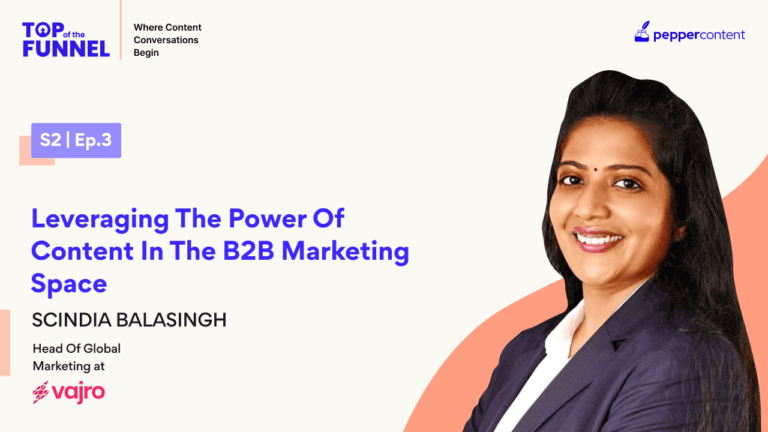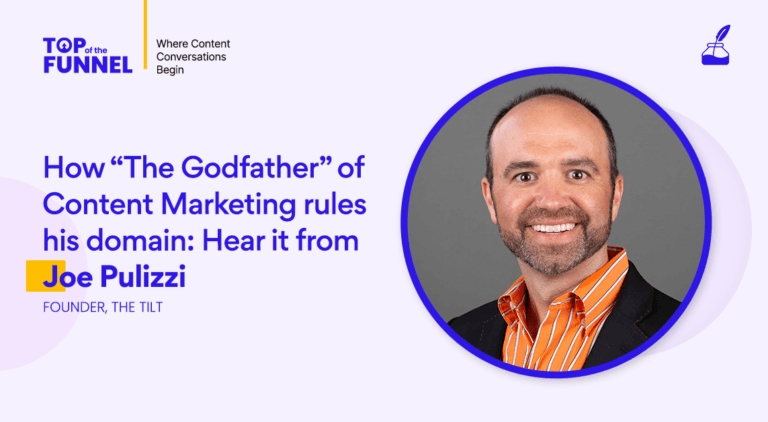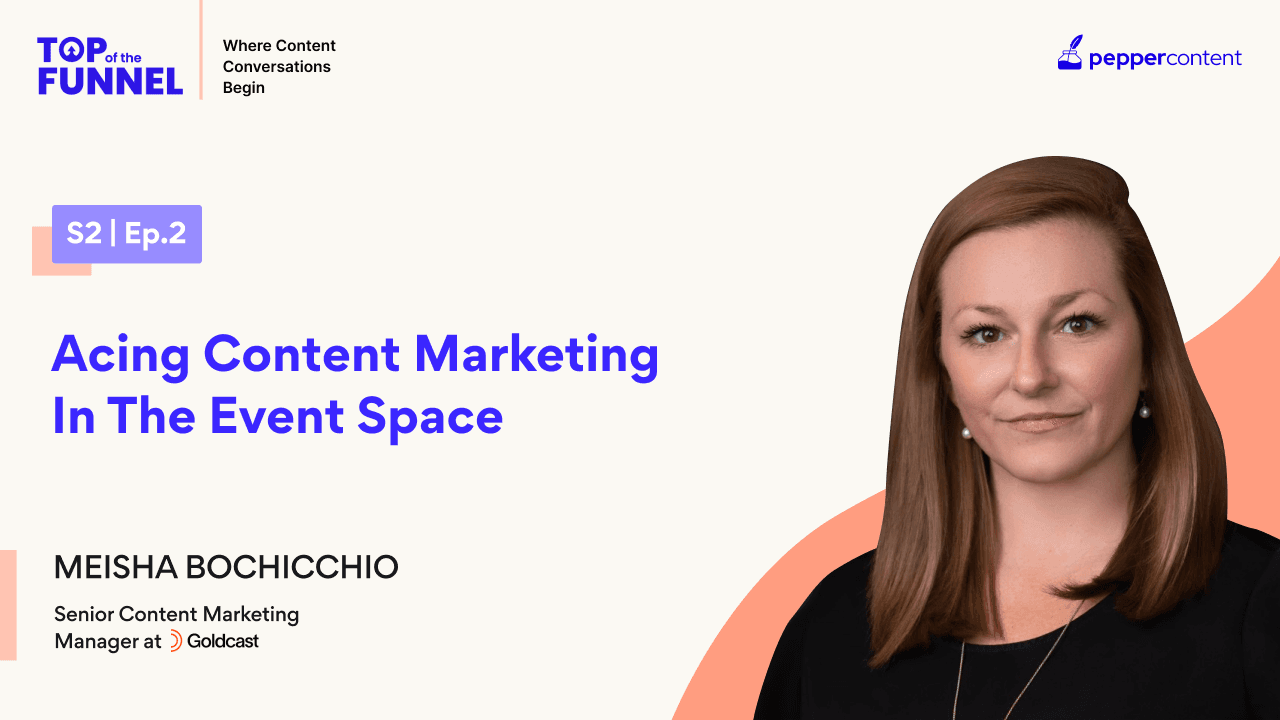
Getting started with content marketing is not a cup of tea. In the digital era, every business needs content to establish its dominance in the market and among competitors, and what could be a better way to achieve it other than quality content? Simply put, content is no longer something that’s good to have. It has climbed way up the ladder of priorities and secured its place among the necessary assets of any business.
In this episode of Pepper Content’s Top of the Funnel, Natasha Puri, Content Marketing Lead at Pepper, connects with Meisha Bochicchio, Senior Content Marketing Manager at Goldcast sheds light on the nuances of event marketing, how companies and marketers can get started with content marketing, and answers queries such as ‘What does it take to create good content?’, ‘What are the qualities of a good content marketer?’, and more. Meisha has previously worked as the Content Marketing Manager at Wistia, a video-software company.
Natasha Puri: Hi, Meisha, what a pleasure to have you with us and we’ll jump straight into it. So I’m going to just start with a very basic question and I’d love your insights on this. So if someone is getting started with content marketing in their organization, what do you think are the first three or five things they should be doing?
Meisha Bochicchio: Yeah, great question, and thank you for having me here today. I think I pull off of the experience from this. This is my third dedicated content marketing role, so definitely made a few mistakes early on in my career. What I would say now based on my experience, is the first five things you should do, number one, learn the product or service. So I’m coming at this with a B2B SaaS perspective. But even if you work in something that’s more service-oriented, you should be a power user of your product or have very deep expertise in whatever field you’re working in. So go through the onboarding, go through client training sessions, do the academy or the certifications, if that’s something that your company offers, and get inside the product.
I work in Martech, so I can use the products that I’ve marketed, which is great. But even if that’s not an option for you, let’s say you market an HR software and partner with the teams that do use the products. You can get inside how they use it. Do whatever you need to do to deeply understand your product. This gets a little bit more complicated if you’re working in an enterprise where you have maybe solutions consultants or you have a robust product marketing team, that’s great. These people are your friends, and you should cast them and partner with them. But really, you need to know at least the fundamentals and the basic understanding of your product or service. So that’s number one.
Number two, I would say, is to get to know your customers and your community. So even if you’re not in a customer client-facing role, which most internal marketers are not, make these folks your friends. So meet with people across sales, across onboarding, across customer success. Support all these different roles that directly interact with your audience. You need to be talking to them if possible, you know, get on your call recording software and listen in on conversations. And even better, if you’re able to reach out directly to some of the customers or your community members or even people that are your target persona, just have real conversations with them. That’s number two.
Number three, I would say, is learning the business and marketing priorities for the year and then how content fits into the overall picture. So really thinking about at a high level, what are the company goals for this year more specific than what we need to generate revenue? That’s a given, right? Your company needs to make money but what’s the overarching vision and what are the top two to three priorities? And also understanding how the company grows. Do they have a product lead growth model very popular in SaaS? Are they more enterprise and do you have a sales lead growth model? So figuring out how the company grows and generates leads and nurtures those leads, that’s a really helpful context when you’re studying your content strategy and then also understanding the revenue breakdown. How does a company make money or what are its biggest focuses? Is it generating net new business? Are they moving upmarket or more enterprise? Do they have an ABM strategy? What are those types of target accounts thinking about retention? Is that a priority? Are you trying to reduce churn and increase the loyalty and stickiness of your product or service or upselling and cross-selling? Are you trying to generate more revenue per customer? Again, all very helpful context when you’re thinking about your content priorities. From there this will funnel down to marketing. How does marketing feed into these goals? Does the marketing team as a whole own a pipeline or revenue goal? And then from there, this trickles down into content individually. So I think any time you’re thinking about the content you can’t just walk into it with a – we want to increase organic traffic as a vanity goal. It has to level up to these bigger marketing and company goals. So that’s number three.
Number four, getting a little bit closer to content. Creating or refining your style guide. This is something that I think goes overlooked or you might already have one and that’s great, but take the time and dig in there and see your folks happy with it. Does it match where the company and the brand are today? Is it being used and is it consistent across your writing and your channels see if it needs any changing or updating and maybe your company doesn’t have one. Great. This is your opportunity to create that and build that for your company and start building this holistic tone and voice that is seen across all of you. Not just content but all of your communications. This is something I had the opportunity to do at Goldcast and was a priority zero item for me to create this guide for all of our comms and then finally we’re getting the content.
I’ve had four things you should do and we haven’t talked about the content yet. But I think after you’ve done all these other things and have the context you need, then you can start your auditing, benchmarking, and planning. So getting access to the tools that you need or having the ability to ask for tools that you need to do your job effectively, learn the existing processes, the workflows, and improve those as needed. Don’t go in right away and start making all these changes. Get a feel for the lay of the land, and how things work, and then start making those changes. And then do your content audits, your mapping, seeing where your gaps are. All those other things come after you get the context that you need to feel informed and confident that the plan that you’re creating for content in your programming is going to impact the business.
Natasha Puri: I love the fact that we hardly spoke about content because I truly feel that we don’t talk about it enough. But this whole piece has so much stakeholder management and alignment at the heart of it. And aligning with product and sales for a content person is so important before you even get down to any sort of strategy, right?
Meisha Bochicchio: Yeah. And I’ve gone into content roles where my priority was – hey, I’m going to dive into the data, we’re going to start doing some analysis, we’re going to find our content gaps. And you just don’t have the context you need to figure out or help prioritize what’s going to have the most impact. And this is important too, for content marketers to think about, start benchmarking and understand how your performance is being that way. You have alignment. If you build all this organic traffic, great. But if that traffic is not doing anything to impact the bottom line, it’s not a success. So I think having that context to know what’s important to the business and how content can contribute to that is important before you get started.
Natasha Puri: Right, so you’re at Goldcast right now, where you’re the event content marketing person, right? And before this, you were with Wistia and which was a video content marketing space. So two very hot kinds of spaces. Everyone’s talking about events and the pandemic has changed the game completely. And everyone’s also talking about video and video is at the heart of content marketing right now. So I want to know what are the similarities and differences between these two roles. Where do you think the content marketing you’re learning from Wistia, is working for you, at Goldcast, and vice versa? What are the similarities and differences you see in these two spaces?
Meisha Bochicchio: Yeah, definitely both very hot spaces. I will say I feel lucky to be in such an emerging space. There are some similarities between both. I mean, they’re both Martech companies you’re marketing to marketers, which is very fun, but also very challenging at the same time because marketers know they’re being marketed to. So it has to be high quality. A lot has changed very quickly in these two spaces, video and events. So 2020 is when I started at Wistia which was a huge year for them. They exploded because people overnight almost were like – hey, we need to figure out a way to reach our audiences in a different way that doesn’t involve interacting in person and I’m f seeing the same thing at Goldcast, where people were throwing these huge in-person events and conferences and the way we do business is just fundamentally changed. So that’s been very similar across both companies.
There is still a lot of educating, so a lot of marketers were thrown into creating video content or planning events, especially digital events, and webinars, without having a background in that. So there’s a lot of educating folks and back-to-the-basics type content that I focused on at least. And even at Goldcast, in addition to this deeper rich content for our power users, it is a very full funnel. There’s still a lot of educating folks on how to do great digital events. So that’s been exciting.
I think something similar across both companies was that both video and digital events tend to be owned across multiple teams. And we kind of target multiple personas. So at Wistia, video can live across sales, marketing, customer success, and support. There are so many use cases for it. And we’re finding that with events as well. Some large companies do have dedicated event marketers, and that’s great. Some don’t. So some are like me, they’re in content and they’re also tasked with hosting webinars. Sometimes it lives. Even if they have a core events team, they still have a product, own it for product launches, and there’s an internal HR team that owns it for company events. So it’s been very interesting learning how teams are using a single tool across teams and knowing how to talk to these multiple personas. Those have all been fairly similar.
I’ll say that I think the key differences that I’m finding are, number one, I think video as a whole is a more mature category, and Wistia has a really strong brand in that space. So that was great for me, creating content, because getting results, even in terms of just driving organic traffic, driving links was a little bit easier. There was also a much higher bar. Wistia has a super strong brand and that’s important to them. We have the resources to support that. We had an internal video team, a studio, a video studio, like a dream setup. We had internal writers, we had a very robust design team. We had an editor, we had a dedicated copywriter. So all these things went into making super top-tier branded content, which is great. I think events as a category are mature, but digital events or digital-first events, hybrid events, this whole technology aspect is still very new and people are still figuring it out. And we’re very much a startup, right? We don’t have ten-plus years of authority in this new space. So that’s where we’re focused on building that trust, building that authority with our audience, and perfecting our point of view, which is great. And just being a little bit smaller too.
We can move a little bit faster, and be a little bit more agile, so that’s a little different. And then finally, I think Wistia, as I mentioned, has a really strong brand and that’s very important to them. I think Goldcast is a little bit different as well. We don’t have that brand recognition. People don’t necessarily know about us or trust us, yet we are very focused on celebrating and elevating our community of event marketers. So this is a top-line company-level goal that is reflected throughout all of our content and our comms. And I don’t necessarily have as big of a community focus. So as Goldcast, we launched an event marketing and field marketing compensation report and hosted a career workshop for folks. We have event marketers live show that’s dedicated to interviewing event marketers and event leaders. We released a list earlier this year of top B2B event marketers. So we have this really strong narrative around event planners, how they’re not the same thing as event marketers, and rallying behind these B2B event professionals. And I think that’s been successful for us and that’s how we’re working to build this trust in this brand.
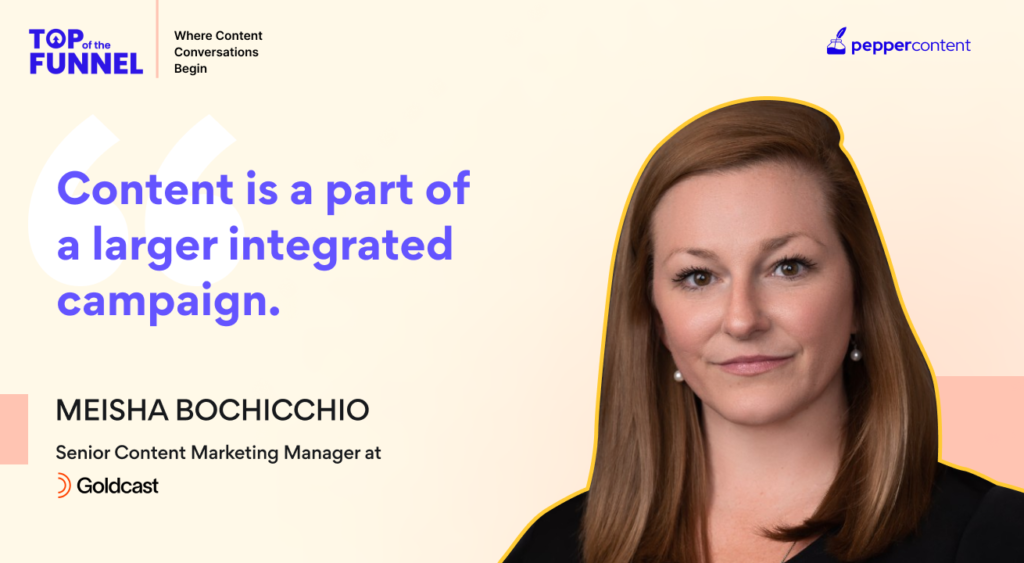
Natasha Puri: So, talking about success, my next question is actually about some campaigns. Where do you feel you have found success and then how do you as a content marketer measure that success?
Meisha Bochicchio: I always try and think of content as part of this larger integrated campaign. And right after I started at Goldcast, we launched a compensation report which, as I mentioned, was kind of tied into our community focus and wanting to support event marketers. So this entailed surveying our audience of event and feel marketers and asking them to candidly share information about their titles, their salaries, bonuses, and really anything that went into their compensation. And then we created a report about it. But instead of just launching and saying – here you go, launching the report and moving on, which happens a lot in content – I’ll be the first to admit we try to focus on building a whole campaign around this. So, as part of this launch, found and partnered with a career coach and we hosted a workshop-style event that served as the launch for this campaign. And we wanted to build excitement and buzz around it and provide value to our audience outside of just – here are the numbers, here you go. We wanted to help them say – hey, here’s a benchmark for your salary, for your career. Come to this event and we’ll help you make it even better. We’ll help you negotiate a better salary, we’ll help you level up your career – so that was kind of the timing of it.
We also teased the report as a way to get people into the actual workshop event. Attendees got their free copy of the report right after they came to the event. And then post event, we dripped out stats on social for six weeks. Then we had our design team create some nice animated images that stood out on the timelines and we used these little dripped-out teasers as a way to drive people into the full report and watch the event on demand. And this worked well on social. It started a lot of conversations, which was important to us. There was a lot of engagement, with people tagging their friends in it, and people commenting. So that was important to us.
I think in terms of success metrics, we considered this a brand campaign. As I mentioned, that leveled up to our overarching goal of supporting and elevating our community, which again, is super important to us right now. We’re a startup. We don’t have all of this built-in authority and trust with people. So this campaign was a way for us to provide something unique that no other company has offered folks and to start building this recognition and trust as the authority and expert for B2B event marketers.
That said, leads and revenue were not goals for this campaign. Certain campaigns can have those goals, and that’s great but for this particular campaign, this was not a goal. Instead, what we did look at were event registrations in attendance. Was this topic resonating with their audience and were they interested enough to show up live to the event? So, looking at your registration for the attendee rate was important. We also looked at engagement during a live event. So things like a live chat. We launched polls during the event. We had a Q&A during the event. We had a video Q&A where people could come up on stage and interact with our career coach. So let us know, are people excited about this topic? Are they sticking around during the event?
We also looked at social engagement. This is something that we focus on specifically for LinkedIn. We do not have a full-blown social strategy. We very much focus on LinkedIn because that’s where our audience is so we looked at every one of these little drip teaser posts, we looked at our people like it, are people commenting on it? Are people sharing it? Is this starting conversations? And the same with the report itself. Looking at engagement on the report, are people spending time on the page and reading it? Are people watching our workshop on demand? Are they finding value in that kind of as a bonus? I think on the cake, we do rank on the first page for that marketing salary, obviously, below Glassdoor and some of those other sites you kind of expect. But it was a positive signal for us to see. Even search engines agree that there is value in this data and the content that we’re able to provide. So it wasn’t necessarily a goal going into the campaign, but it was great to see afterward and I’ll take that as a success metric as well.
Natasha Puri: So since we’re talking about metrics, I think there’s a lot of obsession over measuring the impact of content marketing. Now, I don’t know which side of the debate are you on because there are people who say that you can’t measure it completely and we need to stop being so obsessive over it. But you’ve also spoken about vanity metrics. In your opinion, what are the right metrics? And in the past, how has that impacted your strategy? Because I think we should be measuring something, but then what is that something?
Meisha Bochicchio: I’ll throw out a marketer’s favorite answer here. Should you be measuring things and what are the right metrics? It depends. I think about content in three buckets – search-driven content, thought leadership content, and sales enablement content. And each of those different types of content has different purposes and should be measured differently. No unicorn piece of content can accomplish all of these things. Maybe there are, and I would love to hear ideas that people have, but that’s kind of how I think about it if you have different types of content for different goals. Understand your business and your marketing goals, those to the types of content that are most relevant, and then you can back into some KPIs from there.
Broadly speaking, for search-driven content, if you’re trying to drive organic traffic, looking at rankings, looking at your organic traffic, and ideally just compounds over time, and looking at least generation, these people are coming to your website and interacting with your content, that’s great, but what else are they doing? Is it valuable enough for them to sign up for an email or free trial if that’s a relevant ask?
If you think about something like thought leadership, this is sharing your point of view and trying to build trust and authority. So positive indicators of that are links generated? Is it buzz-worthy enough to other folks who want to link to it or reference it or share it, email, or subscribe? Is this a good enough point of view and strong enough for people to want to subscribe to your email list and hear more from you about this topic? And also just conversations, and engagement on social. As I mentioned, this is important for us on LinkedIn. Specifically, are people commenting and engaging with the content that we share there? And then if you think about something that’s more sales-enabled or more product-focused, this typically tends to be a lot more bottom of funnels. So is this generating leads and converting people? If you have a product-led growth movement, are you able to get people into your free trial? Are you generating demo requests or is this content that the sales team is using during their conversations that help move the pipeline along or close deals? Those are different things you can look at for these different types of content.
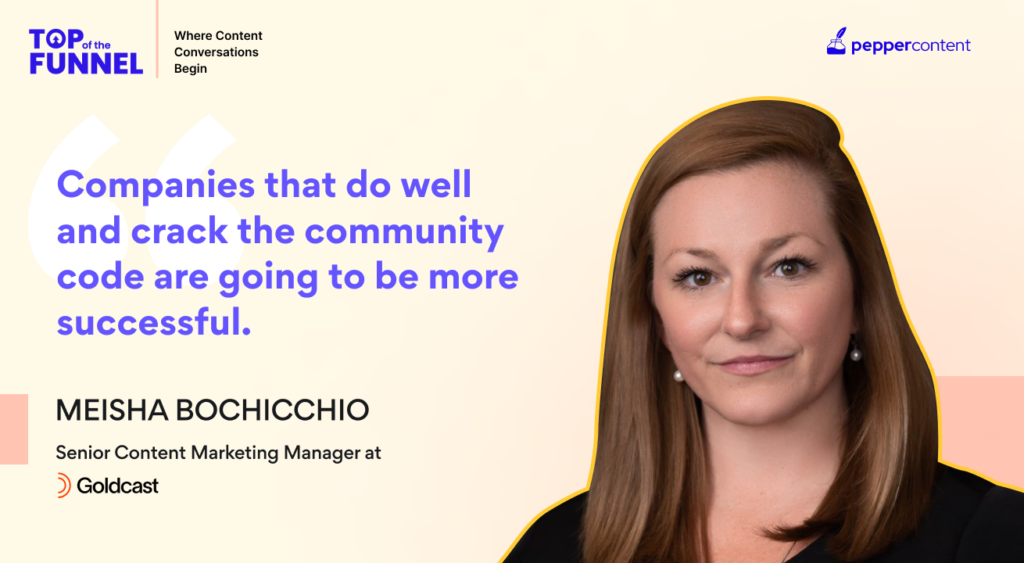
I will be the first one to say that I’m still learning a lot in this space. We’re right now experimenting with some HubSpot dashboards to track attribution because we do want a better picture of what content is working to engage our audience to generate these leads and to help leads move along. So it’s a work in process for sure, but I’m excited to have a little bit more of a holistic data-driven view. I think qualitatively, you can look at things like people sharing or referencing your content, and feedback from the sales team about what’s working. We’ve had people that have responded to sales emails or conversations like – hey, I love this piece you did on XYZ. Or hey, that was a great event, thanks so much for sharing. To me, that’s super powerful and a really strong indicator that yes, this is resonating. Or if you have a really strong point of view about something, when people start adopting that language and your ideas, that’s how you know that your content is working. I thrive off of the qualitative stuff. Numbers are great, but as all marketers know, attribution is made up. So I much prefer the type of feedback where someone responds to an email or reaches out and says – hey, I love your content. That’s, to me, the strongest signal that says this is working, we’re doing something right. So I agree. Not as much as we try to grapple with numbers and come up with ROI, I think there is a gut feeling to it and some of that more qualitative stuff is just as important, if not more important than the actual numbers.
Natasha Puri: I want to understand how content marketing is structured at Goldcast. How do you guys do it? How big is the team? How do you split all of this up? It’s a lot. So how do you manage this?
Meisha Bochicchio: I am a content team of one. Broadly speaking, from a marketing team perspective, we have our CMO, who is Kishore, who’s one of our co-founders. We have Kelly who is our head of growth. She is Kishore’s right-hand woman and is responsible for running the demand gen. So I technically level up to Kelly on the demand gen team and I am in charge of all of our content operations.
For a content manager, this was intentional when I took this role, but I don’t do a ton of writing. I am more responsible for the operations side of it. So I do work with a content agency called Pointed Copywriting. They are fantastic, super happy with them. I work with a few freelance writers as well and manage their workflow. I work with an SEO consultant as well. So I’m in charge of managing our search engine growth and our organic growth. So that’s what falls in my bucket. It also helps because we’re an event company, so most folks on our marketing team are somewhat involved in events. So I’m also tasked with running our webinar programming. And like I said, I’m a user of Goldcast. So I do the full planning, the topics, sourcing speakers, posting events, moderating events, post-event follow-up, and all that fun stuff as well.
For me, broadly speaking, it’s content ops. The webinars and SEO are kinds of what falls on my team, but it is just me. We have a small events team as well. We have a small in-house design team and web development team, which is great to have some of those folks to work with as well.
Natasha Puri: So this outsourcing model works well for you?
Meisha Bochicchio: It does. It’s helpful to be able to have multiple partners that we can work with. And the turnaround time is pretty quick, so it’s been helpful to have those external partners to work with. I think as we grow, we might look to add more internal folks specifically for the content team. But right now having a handful of external folks that can kind of specialize in specific areas is very helpful.
Natasha Puri: What do you think is the future of event marketing and what is the role that content is going to play in that?
Meisha Bochicchio: I work for a digital and hybrid of that platform. I’ll be the first to admit that in-person events are not going away. There’s no substitution. I’m going to an event next week that I’m excited about. There’s absolutely no substituting. That is the value of connecting with people in person. But there is a ton of opportunity in the digital and hybrid space. So I do think that more companies are going to pull back on these huge, large four-day conferences. Not every company I don’t see inbound going anywhere, right? But for every other company out there, I think the spend is just so high and it’s really hard to determine the return on that versus doing much smaller, more thoughtful, intimate events. So planning more field events, smaller, localized events, rogue shows, is something that I’ve seen more companies do, where they go, they hit a few cities and host more curated events for a smaller group of people and also embrace more of the digital events and hybrid events. So I think there’s a lot of room to grow for digital, especially for people that do it well.
Digital events do not mean hosting a webinar in that you’re talking at the screen for an hour with slides. That’s not a digital event. Really thinking thoughtfully about the experience and how you can provide value to your audience and also embrace the convenience of digital, having the option, the flexibility of hybrid, these are things that event teams are going to have to think through when they’re thinking about how they’re creating this holistic event strategy. So, in smaller in-person events, more digital and hybrid events, where content plays a part. I think that thinking about the campaign model for marketing is the smartest way to approach this. And I think events are such a great opportunity to think about it as a campaign. So you have a cornerstone event at this moment in time, but then you take all of this great content from this event and continue to recycle that and repurpose that content. So take your sessions instead of just hosting on demand and sending out an email and calling it a day, how can you repurpose every single session into a dedicated piece of content? A guide, breaking it down on social. There are so many different things that you can do with your event content outside of just hosting the event. So I think the smartest teams out there are going to embrace this campaign approach and say – hey, we’re doing this huge cornerstone event. This is going to fuel our content flywheel for the next six months. So that’s where I see content playing a part of that.
Natasha Puri: So do you think the community is going to start playing a much bigger role when it comes to content marketing, specifically to an event or even overall? Because I just heard this word now being spoken so closely linked to content, right? So what do you think?
Meisha Bochicchio: Yes, the community is a very buzzy term right now, but I do think companies that do it well and crack the community code are going to be more successful. I think there are a lot of people figuring out what a community means for us. What does it look like? So it’s more than just a Slack group and having people sign up and chat on Slack. I think it is like understanding your persona or your users and deciding what type of community you have. There are all sorts of different types of communities. Do you want to have just a user or a customer community? Do you want to be a little bit more open to just your target persona and make it more of a thought leadership-type community? So I think there’s a lot more strategy that goes into the community than people think when they just hear the word community. So I think it is more work than people think when they sign up for it. But I do think that the companies and the brands that do it well will find success if they dedicate the time and resources to nurturing those folks.
Latest Blogs
Explore how Google’s 2025 AI search updates triggered ranking chaos. Learn actionable strategies to adapt your SEO for AI Overviews, zero-click searches, and SERP volatility. Stay ahead now.
Learn how to rank on AI search engines like ChatGPT, Perplexity, and Gemini by optimizing your content for authority, structure, and relevance. Stay ahead in AI-driven search with this strategic guide.
Explore the best healthcare SEO services for your medical practice. Improve online visibility and effectively reach more patients in need of your services.
